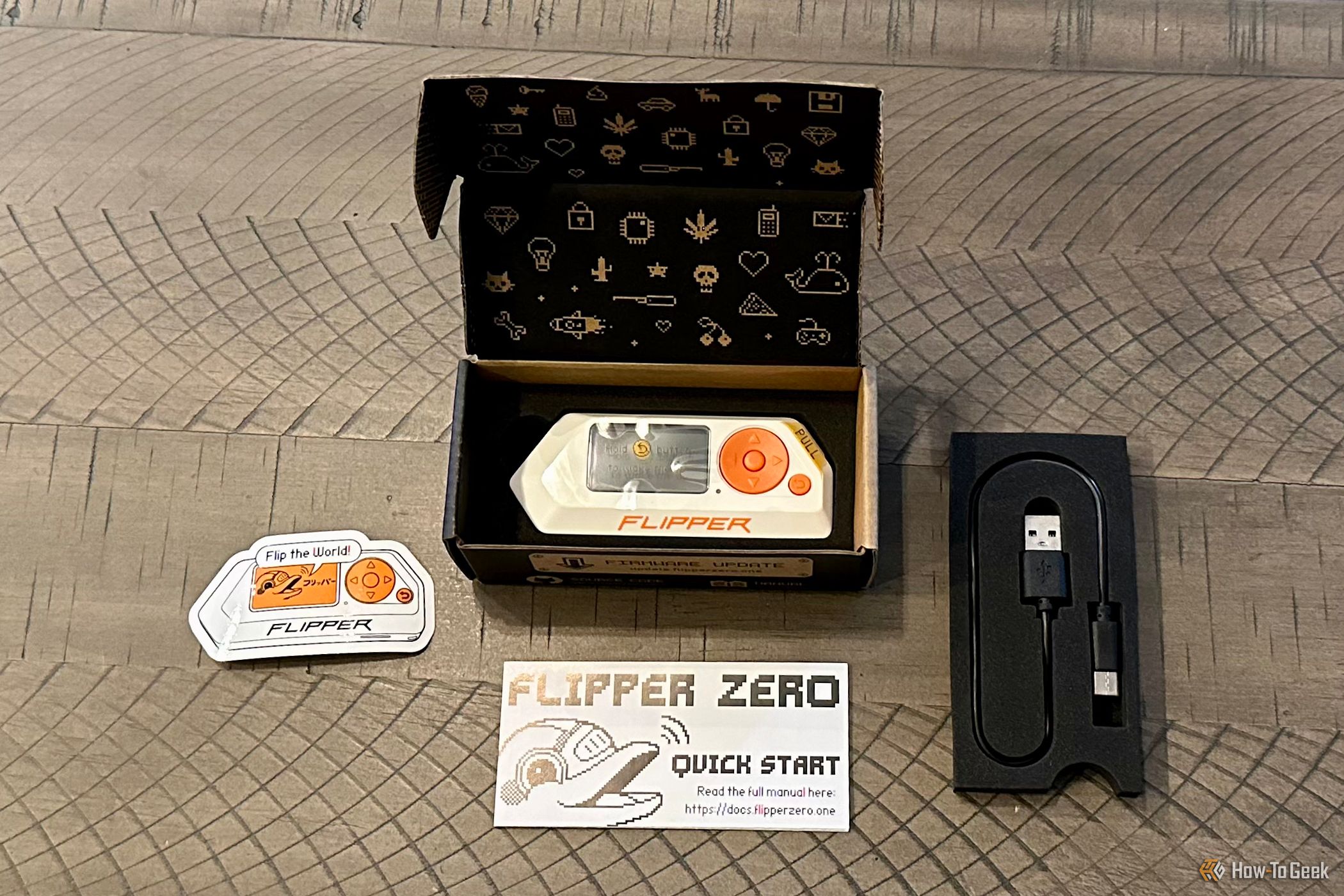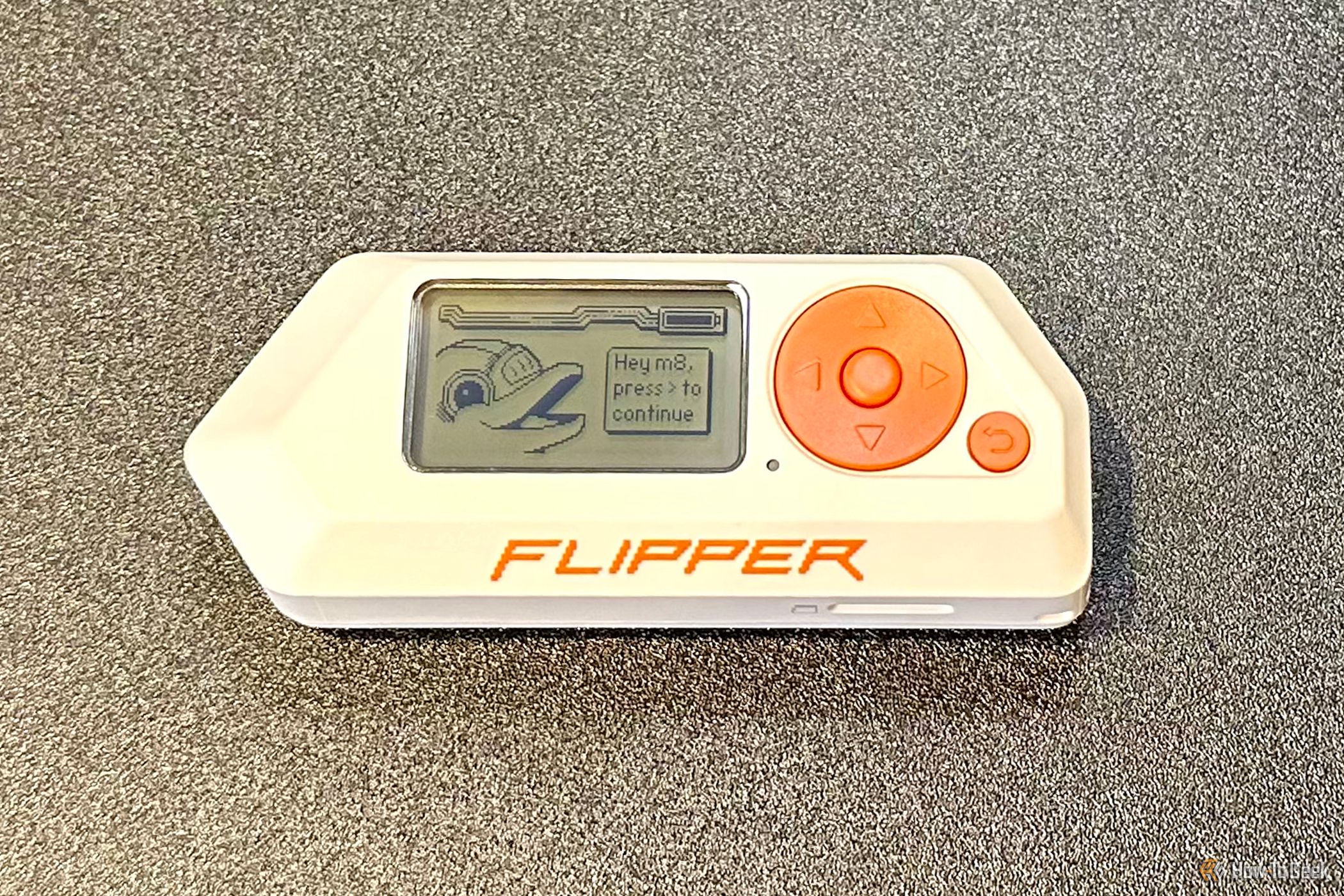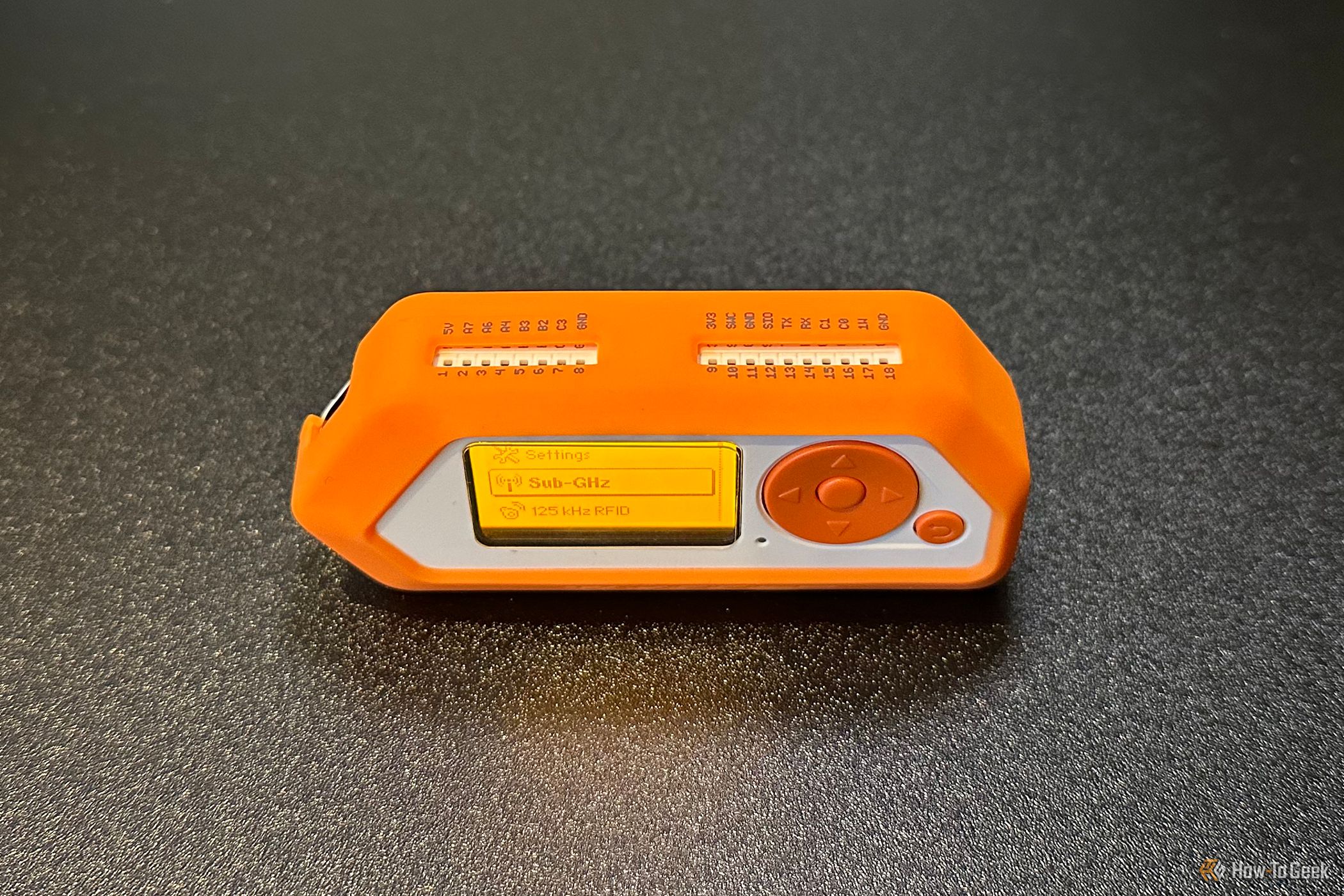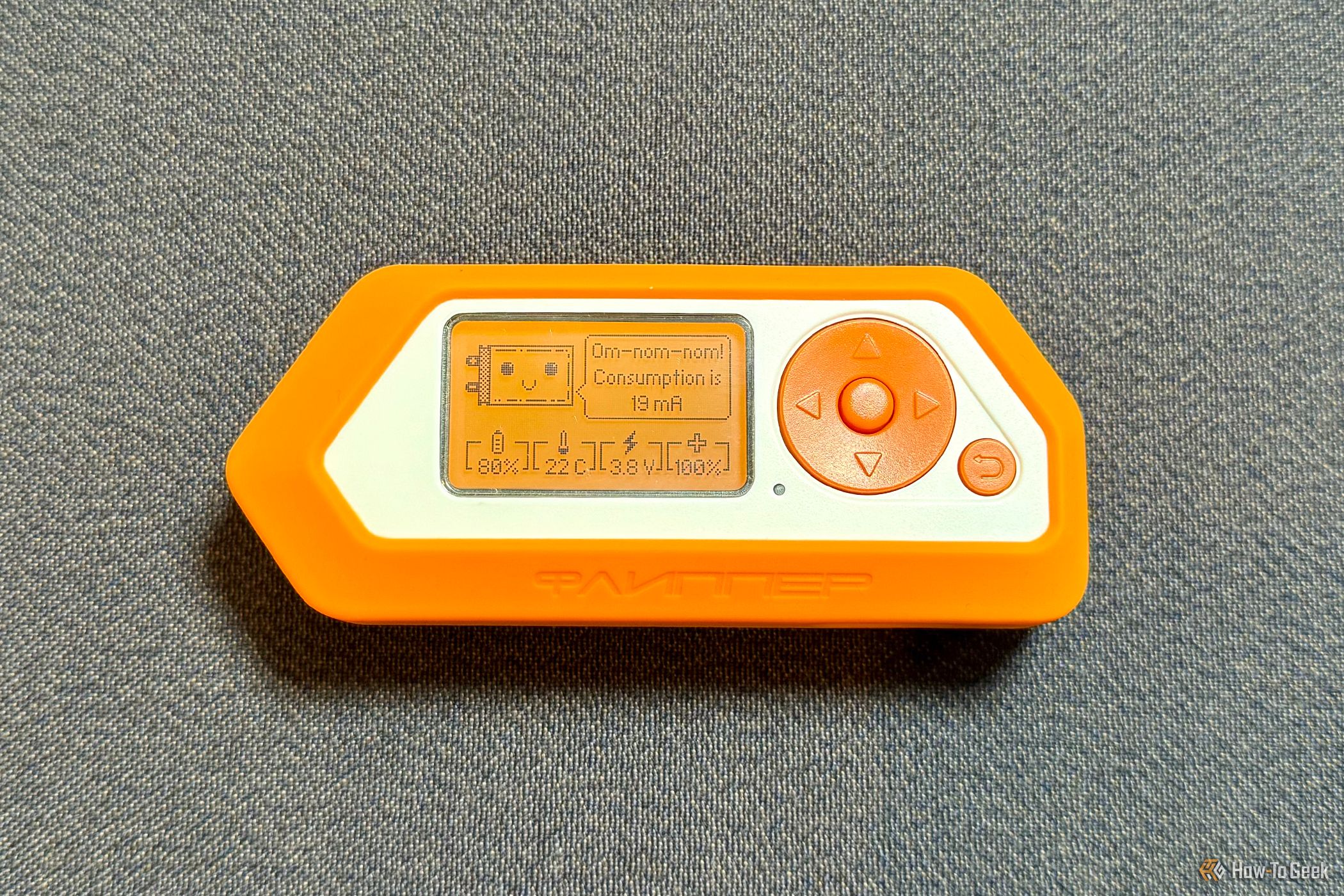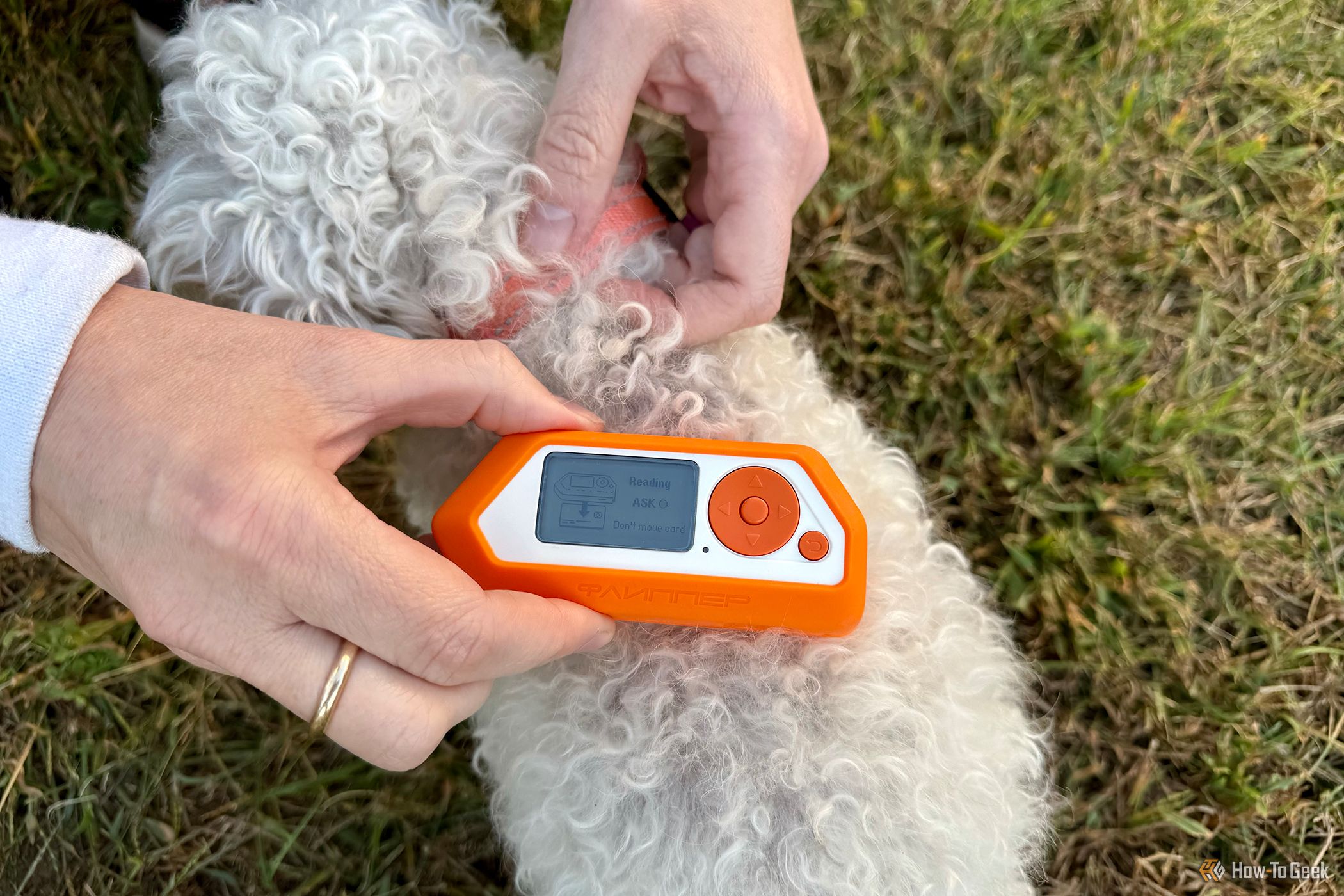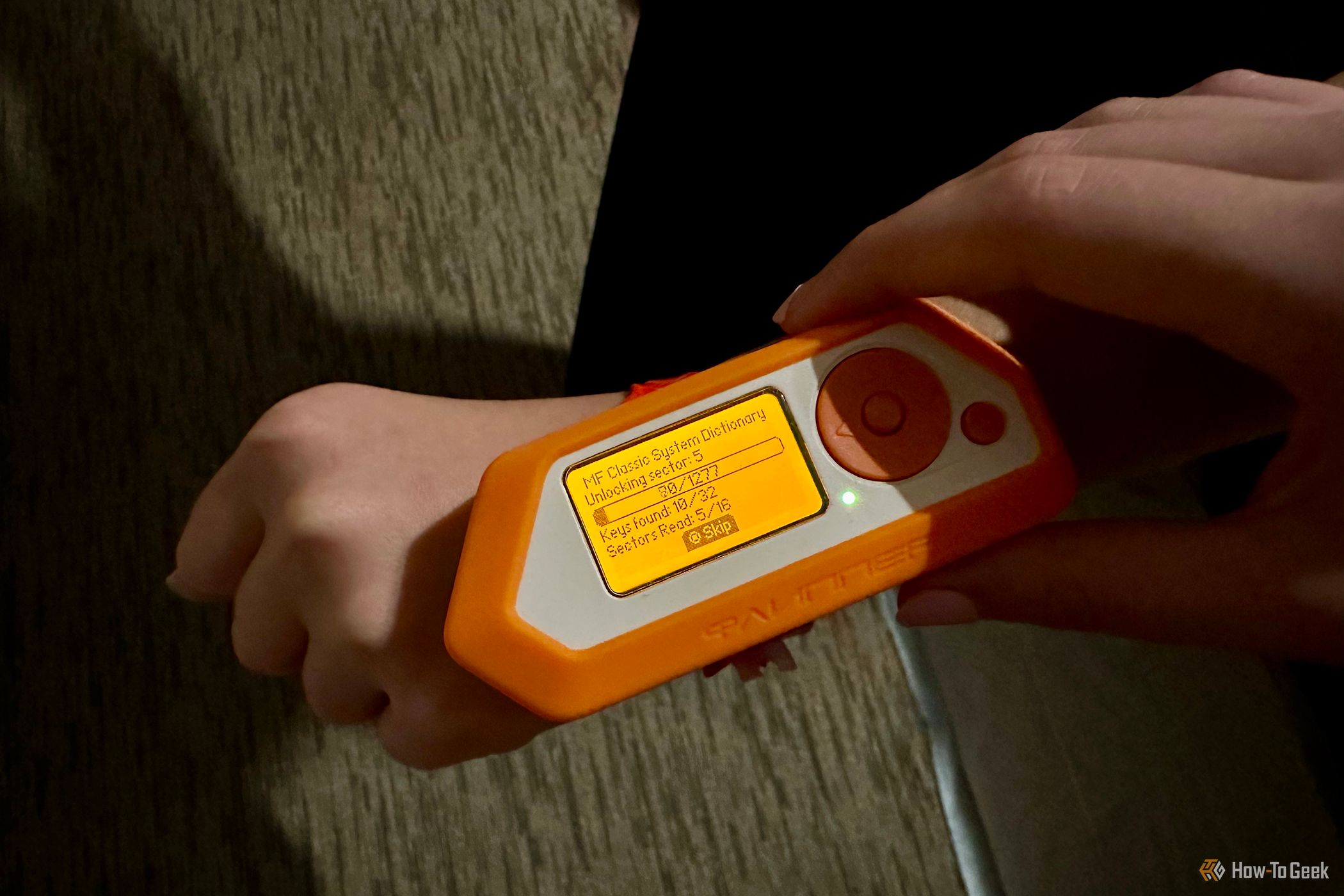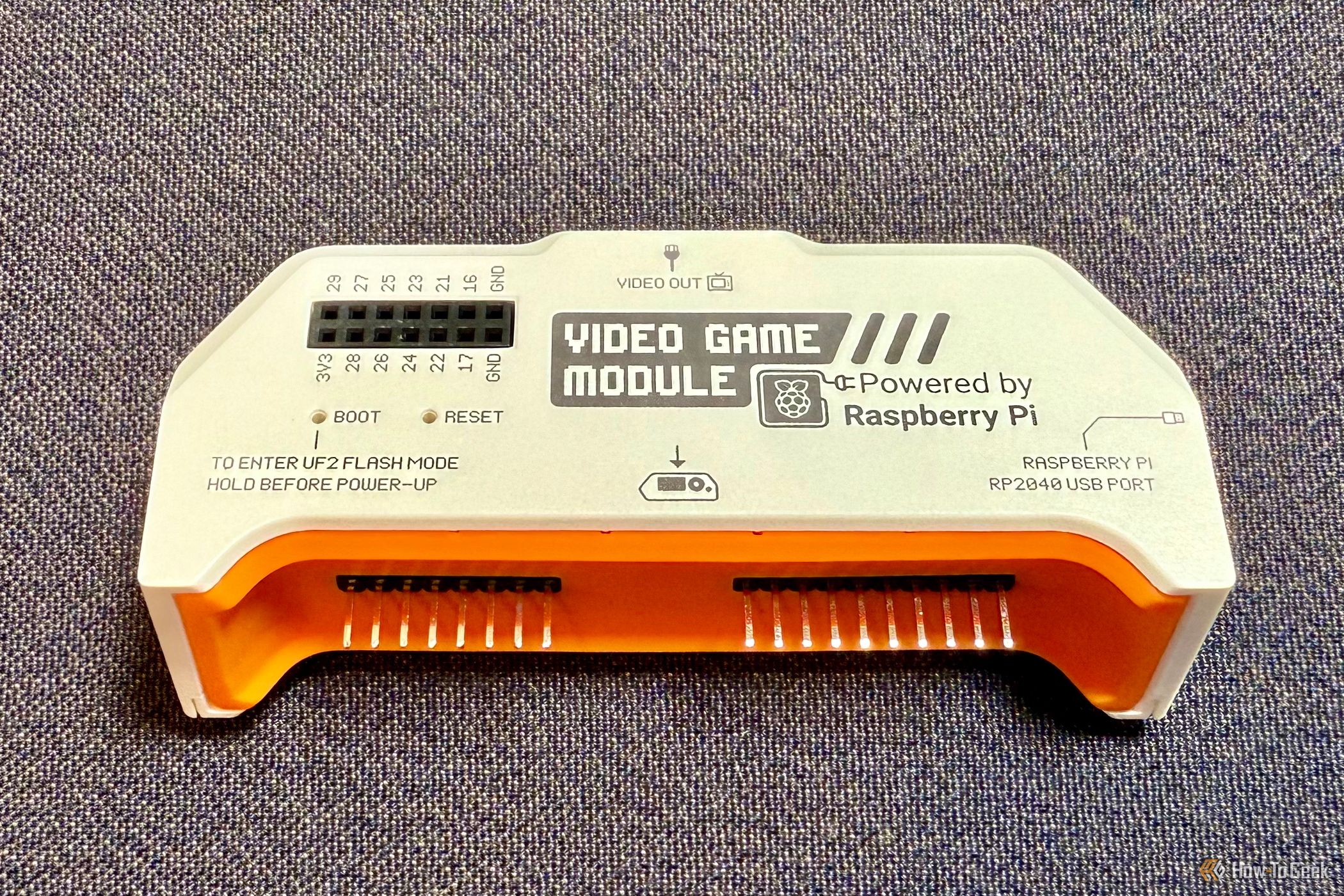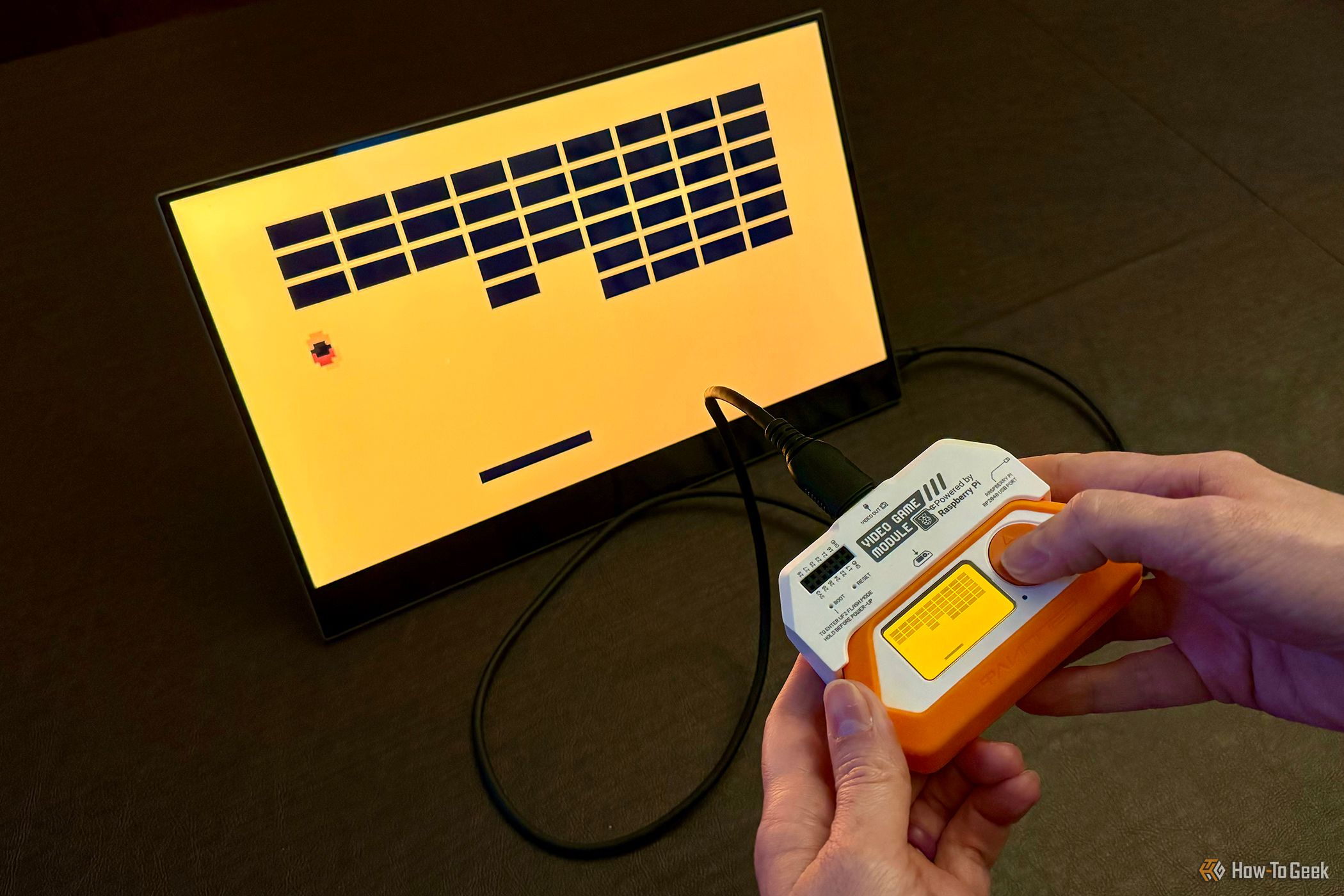Key Takeaways
- Flipper Zero is a versatile tool for dedicated tech enthusiasts but struggles with everyday use cases.
- It features an evolving cyber-dolphin pet, firmware updates via app, and a diverse app library.
- Accessories help to round out the feature set.
Despite being billed as a “multi-tool device for geeks,” the Flipper Zero tries hard to have broader appeal. It’s a small, chunky handheld device with a simple monochrome LCD display and a handful of buttons. It also features a playful cyber-dolphin as both its ever-present mascot and Tamagotchi-like pal, who evolves as you use the device. Although the Flipper Zero can autonomously interact with and control an impressive range of modern electronic devices, ID cards, and wristbands, finding everyday use cases might be one challenge this handheld can’t overcome.
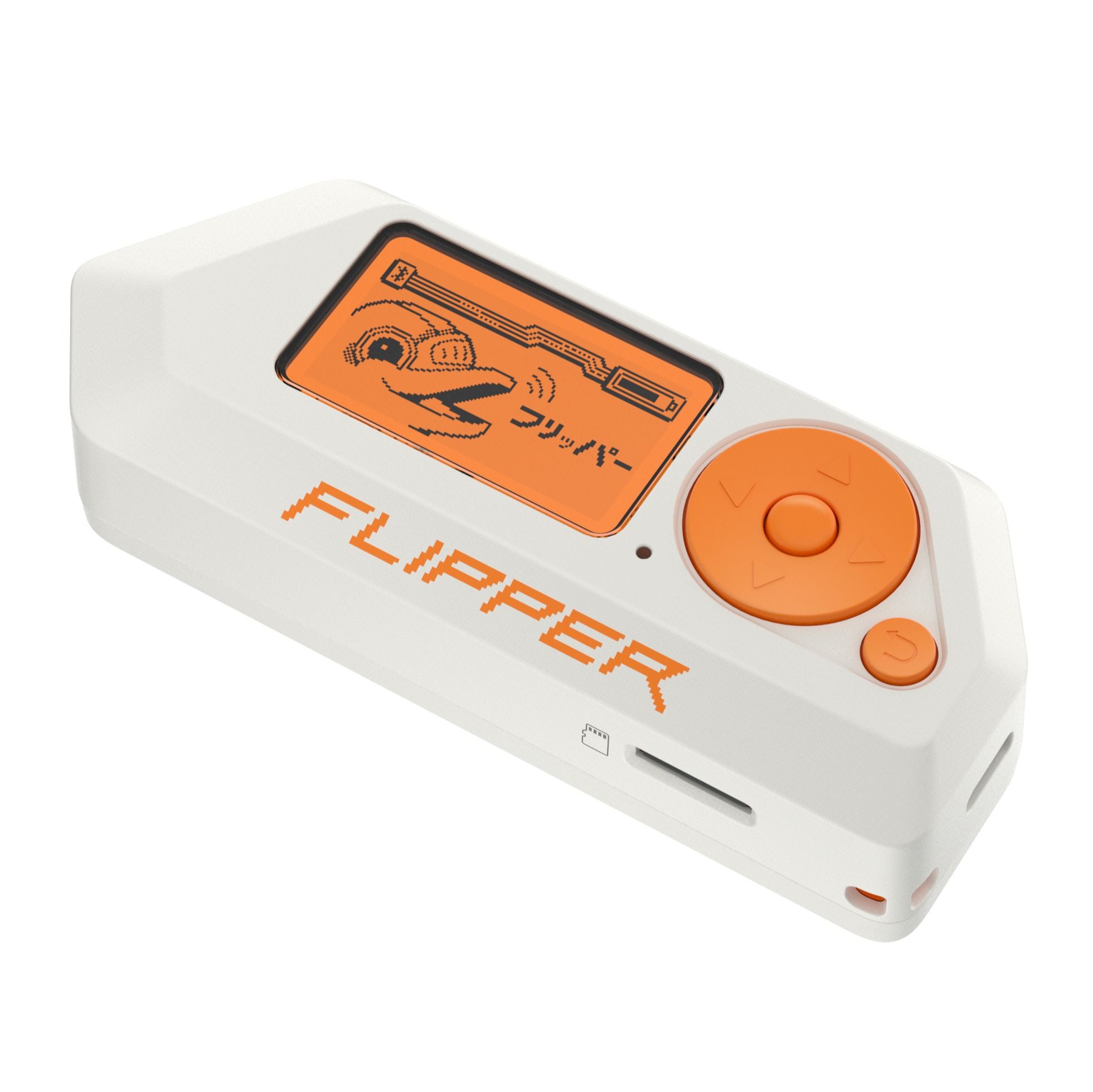
Flipper Zero
The Flipper Zero is a portable multi-tool electronic device in a toy-like body that’s designed for experimentation.
- Remotely interact with many devices
- Extensible and expandable
- App store
- Unique virtual pet
- Steep learning curve
- Tough to find practical, everyday use cases
- No touchscreen
Price and Availability
The Flipper Zero is available directly from Flipper Devices Inc. for $170. It comes with the device, an 11-inch USB-C to USB-A cable, a quick-start guide, and a sticker. A microSD card from 4GB up to 256GB, not included, is required, with at least 16GB recommended.
I tried to use a generic 64GB Hunyeiz card, which Flipper indicated might not work because only authentic microSD cards support SPI “slow mode.” It didn’t work, so I had to use a 128GB SanDisk branded for the Nintendo Switch that I fortunately also had on hand.
Several official accessories are available for the Flipper Zero, including a silicone case ($15), a three-pack of screen protectors ($8), a WiFi dev board ($30), prototyping boards ($10), and a Video Game Module ($50).
Setup and Software
The first step after inserting a working microSD card is to update the firmware, which can be done by connecting the Flipper Zero to a computer using the USB cable and downloading the “qFlipper” app for Windows, Mac, or Linux. Alternatively, you can use Bluetooth to connect to a mobile device and use the “Flipper Mobile App” for iPhone or Android.
Onboard menu selections include Apps, for accessing installed apps, options for Sub-GHz, 125 kHz RFID, NFC, and infrared (IR) reading and writing, GPIO options if you have something connected to those pins, iButton options for reading older 1-wire keys, Bad USB to install qFlipper to a computer and, in conjunction with U2F, can make the Flipper Zero act as a USB universal 2nd-factor (U2F) authentication token or security key when signing into Web accounts, and Settings.
Settings lets you control Bluetooth, the LCD display options and notifications, storage, battery performance and power control, desktop for favorite and dummy mode apps and PIN code protection, Passport for your pet cyber-dolphin’s details and progress, system customization, external module communication settings, and device information.
While either the qFlipper or Flipper Mobile App lets you update the firmware or apps or take remote control of the Flipper Zero, only the Flipper Mobile App lets you install new apps directly from the official library. If you use qFlipper, you have to manually install any apps. These apps cover a wide range of categories, including ones that use specific connectivity options or work similarly to standard smartphone or tablet software like games, media, and tools, just simplified.
With its angular white body, roughly 4-inch width, and thickness of 1.15 inches, the Flipper Zero looks more like a rugged industrial tool than a sleek consumer product. The simple directional pad with center button and single back button and monochrome orange backlight LCD screen with a resolution of 128×64 pixels complete the no-nonsense look and feel.
While it looks like it can take a beating, I’ve seen some pretty distressed Flipper Zeros on the web with scratched screens and bodies. That’s why I was happy to also have the official orange silicone case and screen protector, which add aesthetic appeal and make tossing the Flipper Zero in a bag no big deal.
On the right side of the device is a USB-C port for charging and connecting to a computer and a wrist strap slot. To the left of the wrist strap slot, and on the bottom of the device, is the microSD card slot.
On the left and rear of the Flipper Zero are 1-Wire pogo pins for connecting to iButton keys like access control, temperature measurement, or cryptographic key devices. Flush left is the IR transceiver. Finally, at the top of the device are GPIO pins that feature 3.3V logic levels and are 5V tolerant for input. These pins can be used by dedicated enthusiasts to connect any piece of compliant hardware and run their own code.
Flipper Devices tries hard to put a friendly face on what can be a daunting device. One of its boldest moves in this area is the ever-present cyber-dolphin interactive digital pet. By making regular use of the device, the pet’s emotions, hobbies, and appearance evolve. In short, the happier you make your pet, the more it levels up.
You can view the pet’s details, including a visual representation of its current state, unique name, emotional state, current level, and progress bar by pressing right on the directional pad on the main desktop screen. I suppose because I’ve used the device less frequently than a normal power user is expected to over the past several months, my pet, “G0nsh0n,” was frequently in an Angry mood. He often appeared on the main desktop screen, lazily lounging on a sofa, eating popcorn, and watching TV. One time, he even packed his bags and threatened to leave.
Every time you use Flipper Zero, you earn XP, up to a maximum of 20 XP per day for each application and 140 XP overall. Using the Sub-GHz, 125 kHZ RFID, NFC, IR, GPIO, iButton, Bad USB, or U2F features gets you anywhere from one to three XP. You need 300 XP to reach level 2 and 1800 XP to reach level 3. It’s undeniably a unique and fun way to gamify the use of a device like this, but personally, I’d rather be incentivized through use cases than the guilt of keeping a virtual pet happy.
In terms of run-time, the Flipper Zero’s 2100 mAh battery can last up to a month with infrequent use between charges. It takes around two hours to fully charge over its USB-C +5V, 1A port. An indicator light located between the directional pad and screen indicates status, with red for charging and green for fully charged. You can see the current battery status, including level, temperature, voltage, and health from Settings.
Everyday Use Cases: Compatibility Not Guaranteed
One of the most frequent use cases for the Flipper Zero is controlling gates, barriers, radio locks, remote control switches, wireless doorbells, smart lights, RFID cards, NFC cards, and just about anything that is controlled with an IR signal, including TVs, air conditioners, projectors, audio systems, fans, and more. The basic process is to identify what type of signal a device interacts with, select the appropriate option from Flipper Zero’s menu, and then read, write, or save the information, providing a unique name for the latter. It’s then just a matter of recalling the saved information and controlling the device in the future.
Not much of this type of signal interpretation is intuitive, but Flipper Devices does provide good online documentation for its robust feature set. It’s all but understood that you’ll have some reading to do to learn how to interact with your intended device in the right way.
Another important point is that even if you do everything right, you may still not get a usable result. For instance, when I stayed with my family at a hotel over the summer, we each had a wristband that allowed us to enter our room, access the elevators, and visit the indoor waterpark. While the Flipper Zero could get basic information from the wristband, it wasn’t able to extract the necessary information to replicate its functionality. This is good from the standpoint of the hotel’s security, of course, but it would have been a nice backup if it worked since our wristbands got deactivated several times, requiring a long trip back to the front desk for reactivation.
Of course, when Flipper Zero works as intended, it can be a pretty impressive experience, like detecting FDFX-B or FDX-A pet microchips, which are a key tool for returning lost pets to their owners. Microchip implants, which are roughly the size of a grain of rice and are usually placed on the left side of the neck or between the shoulder blades of dogs and cats, typically operate in the 134.2 kHz range. I was able to read my dog’s microchip by selecting 125 kHz RFID, Extra Actions, and Read ASK from the Flipper Zero menu, then holding the device for about three seconds over her shoulder blades.
The microchip type, microchip data, microchip ID number, animal microchip indication, and her temperature in Celsius were displayed. Although the latter is not considered a replacement for traditional methods that are more accurate, knowing if my elderly dog’s temperature is on the higher side is useful information I otherwise wouldn’t have.
Arguably, the most approachable feature set is the Flipper Zero’s IR capabilities. I used to have fun back in the 1990s using a Casio watch with a built-in IR blaster to change TV channels in stores and restaurants. Naturally, the Flipper Zero can do the same thing, only with far more options. For instance, it has a good range of universal IR remotes for TVs, audio players, projectors, and air conditioners built-in, as well as an easy way to learn new remotes when they’re available, although only on a button-by-button basis. Since it’s a small screen and directional pad interface, you’re limited to a handful of functions, with a TV only having, for example, the essential power, mute, channel, and volume buttons.
While I continue to have fun finding devices, cards, and passkeys for the Flipper Zero to interact with, I struggle to find much use on a day-to-day basis. It’s great as a backup for important remotes and access cards, but I think there’s a reason why Flipper Devices pushes things like the virtual pet and app library. There just wouldn’t be much else to the device otherwise.
Video Game Module: Simple Gaming with a Hacker Aesthetic
The first major official add-on for the Flipper Zero is the Video Game Module, which is based around the Raspberry Pi RP2040 microcontroller. It’s also a great example of something that takes advantage of Flipper Zero’s GPIO pinouts yet is plug-and-play rather than requiring technical know-how to interface with.
The Video Game Module turns the Flipper Zero into a novelty game system, much like the Panic Playdate. Like the Playdate, the Flipper Zero’s limited capabilities, including motion controls and a monochrome LCD screen, add to its approachability and charm.
With or without the Flipper Zero’s silicone case, the Video Game Module snaps easily on top. It’s a nice, secure fit and reasonably well-balanced.
There isn’t a wide range of apps available specifically for the Video Game Module yet, but the ones there do showcase its potential.
For instance, “Air Mouse” turns the module and Flipper Zero into a computer mouse you can tilt and rotate in the air to control the pointer on your computer, while “Air Arkanoid” is a ball and paddle game where you control the paddle by tilting left and right. In both cases, the Video Game Module provides surprisingly precise motion tracking.
The Video Game Module also adds a full-sized HDMI out port, which mirrors the LCD display. While the built-in LCD suffers from motion blur, outputting the video over HDMI minimizes, if not eliminates, the issue.
Finally, the Video Game Module has GPIO ports of its own and can actually be used as a stand-alone device thanks to its USB-C power port. This means you can interface your projects to take advantage of the video out port, motion-tracking sensor, and more.
Should You Buy the Flipper Zero?
The Flipper Zero can autonomously interact with, and ostensibly control, a wide range of devices that use sub-GHz radio signals, 125 kHz RFID, NFC, IR, or USB connectivity, which is everything from Internet of Things (IoT) sensors to fans, garage doors, remote controls, ID cards, and computers. Unfortunately, although its potential is virtually limitless, I struggled to find many everyday use cases for such a powerful electronic tool, and, in select instances where I did want to use its features, it wasn’t compatible due to security layers or other issues.
If you can envision good use cases, the Flipper Zero is an enjoyable experimenter’s tool, but for everyone else, you’ll likely have more utility and fun with more mainstream devices.

Flipper Zero
The Flipper Zero is a portable multi-tool electronic device in a toy-like body that’s designed for experimentation.

